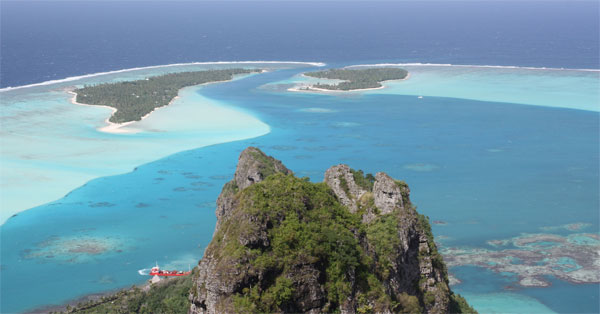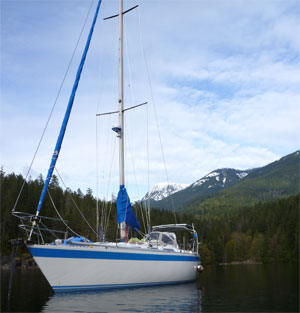
The pass of Maupiti, Society Islands, French Polynesia taken from the summit of Mount Teurafaatiu.
To the editor: In Ocean Navigator issue 54, Cameron Bright wrote generally about tidal patterns and in a follow-up piece titled “The tide schedule that never changes,” Bright expanded on the concept of amphidromic points, places where solar tides, not lunar tides, hold sway. I used an understanding of solar tides to help navigate the passes of two atolls in the Society Islands.
One amphidromic point is near the Society Islands in French Polynesia, a common stopping point for circumnavigators. French Polynesia is composed of five island groups: the Marquesas, Tuamotus, Societies, Gambiers and Australs. The passes in the Tuamotus are known for their strong currents and overfalls.
In the majority of the Society Islands, however, current is less of a navigational issue for several reasons. The most commonly visited of the Society Islands are either riddled with passes which, combined with the small tidal range, minimizes the flow of water in the pass (e.g., Moorea and Tahiti), or have one very large pass in which the effect of the inflow and outflow are diluted (e.g., Bora Bora). Other islands in the Societies are atolls without passes that are rarely visited by voyagers (e.g., Motu One).
 |
|
Livia Gilstrap |
|
Livia Gilstrap and her companion Carol Dupuis’s 35-foot sloop Estrellita 5.10b at anchor far from French Polynesia in Roscoe Bay, Desolation Sound, British Columbia. |
However, there are two gems in the Society Islands, fantastically beautiful and rarely visited, where currents can be extreme. These are Maupiti and Mopelia, both due west of Bora Bora and thus directly on the path of most cruisers passing through.
Similar to the Tuamotus, in times of high ocean swell, the lagoons of these atolls fill, creating a state of constant outgoing current. Maupiti has a narrow, south-facing pass with a turn midway through. Because Maupiti’s pass runs north-south the outgoing current meets the swell and fetch, creating breakers in southerly swell and southerly wind conditions.
Mopelia has an extremely narrow west-facing pass (i.e., approximately 60 feet across) with coral heads on the lagoon side. The west-facing pass makes breakers less common than outside of Maupiti, but the narrowness of the pass creates a turbulent, strong current when the lagoon has been filled by wind and swell. Both passes are potentially dangerous and best avoided when the swell is running high. Further, the published information about the currents in the passes is scarce and conflicting.
Safe navigation into and out of both passes requires a simple set of conditions: a period of time without strong wind or swell with a southerly component and an understanding of solar tides.
Because they are near the amphidromic point, Maupiti and Mopelia are affected primarily by solar tides and have high tide at approximately noon and midnight and low tide at approximately 0600 and 1800. This means that in the morning, between 0600 and noon, the tide is rising. Because both atolls are usually in a state of constant outflow, this means that the outflow current is less in the morning than in the afternoon when the outflow from the full lagoon is combined with the outflow of the solar tide. We timed our arrival in both passes for just after sunrise and we waited until the sun was high enough for safe visual navigation once we had arrived inside of the lagoon. In both cases we entered the pass at around 0800 and encountered one and a half to two knots of outgoing current.
A last tip is that the lagoons in Maupiti and Mopelia fill from similar conditions so if you are interested in visiting Mopelia, you can estimate the state of Mopelia’s pass by the conditions of Maupiti’s pass when you exit.
—Livia Gilstrap and her co-captain Carol have been cruising for more than 1,000 days aboard their 35-foot Wauquiez Pretorien, Estrellita 5.10b. They have sailed in British Columbia, California, Baja Mexico and French Polynesia. You can read more about that unfolding adventure on their cruising blog (thegiddyupplan.blogspot.com).
